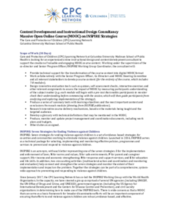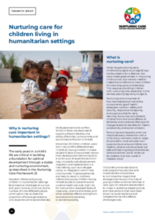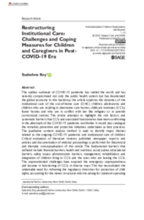Demographic Data
|
Sources: World Bank, UNDP, UNAIDS, DHS 2013 |
Displaying 3121 - 3130 of 14390
Care and Protection of Children (CPC) Learning Network at Columbia University Mailman School of Public Health is looking for an experienced online instructional design and content development consultant to support the creation of valuable and engaging MOOC course content.
To assist governments, civil society and faith-based organizations in their efforts to reduce violence against children, the INSPIRE core agencies and INSPIRE Working Group are initiating a series of eight training webinars over the course of six months. This first webinar in the series will be an introduction to INSPIRE and its cross-cutting elements of monitoring and evaluation and multi-sectoral action.
This brief summarizes actions that programme planners and implementers should take to minimize the impact that emergencies have on the lives of young children and their families.
This webinar discussed work that explores how community conditions that strengthen families can be improved.
This study examined the self-reports of youth in Israeli residential care settings designed for youth from underprivileged backgrounds on the extent of perceived availability of support from their siblings among other sources of support, and the contribution of sibling support to various positive and negative measures of well-being and functioning.
This article explores the dynamics of the institutional care of the out-of-home care (OHC) children, adolescents and children who are residing in alternative care homes, childcare institutes (CCIs), foster homes and who are in conflict with law like refugees or in juvenile correctional centres.
This chapter will record the views of a small sample of elders (now in their 70s, 80s and 90s), who grew up in Barnardo’s facilities in the UK, on being separated from their siblings and how they re-connected with their brothers and sisters in old age.
In this World Bank Blog Post, Saskia Blume and Nour Moussa of UNICEF's Children on the Move Team describe how "millions of ‘children left behind’ are taking the brunt of this fallout as their family members who moved internally or abroad in hopes of sustaining them, cut down on remittances" as a result of the COVID-19 pandemic.
"While orphanages no longer exist in Western Australia, thousands of traumatised children live in out-of-home care in what some child protection staff call 'hidden' residential institutions," says this article from WA Today.
In this report, the UK Local Government and Social Care Ombudsman is highlighting the experiences of children in the care system – and the difficulties they face when councils get things wrong.




